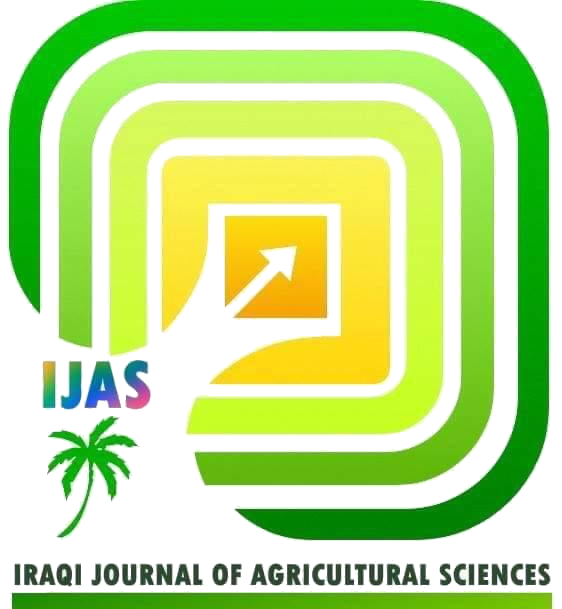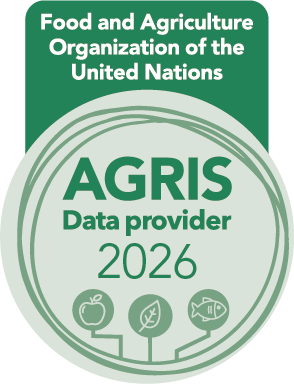BIOLOGICAL YIELD CONTENT CORRELATED WITH YIELD COMPONENTS IN BARLEY (Hordeum vulgare L.) UNDER RAINFED CONDITIONS OF KURDISTAN- IRAQ
DOI:
https://doi.org/10.36103/j2h03x34Keywords:
Barley, biological yield content, correlation, regression analysis.Abstract
Barley is the second cereal crop grown after wheat in the Kurdistan region of Iraq. Low rainfall and high-temperature impact barley yields. A study investigating an F3 population of 100 segregated lines derived from a cross between Clipper, an Australian cultivar known for its high yield, and Local black, a cultivar recognized for its stress tolerance. The segregated F3 lines were assessed under two different environmental conditions at the Grdarash research station in Erbil and the Qlyasan research station in Sulaimani. The field trial data for the F3 population experienced analysis of variance and normality tests. Direct selection of high-yielding genotypes is challenging due to the complexity of the trait. Despite significant differences in yield among genotypes from various sources, genotypes showed no significant differences in harvest index (HI%). Location had a greater impact on yield-related traits of the segregated individuals, with temperature being a major influencing factor In Erbil, biological yield (BY) was significantly correlated with yield and its components, except for 1000-grain weight. In Sulaimani, BY was also significantly associated with yield and components, negatively correlated to HI%. Genetic effects were significant for BY but not HI%, with a negative genetic correlation between BY and HI% in Sulaimani. Significant impacts were observed on all attributes using regression analysis. except for 1000-grain weight, which had no significant correlation with BY or other traits. Biplot analysis indicated significant positive correlations between BY and yield-related traits, except for a negative %HI but insignificant correlation with 1000-grain weight.
References
1. Ahmad, N.S., N. Moradi, J.G. Rafaat, and D.J. Mohammed, 2021. Genetic variability and heritability estimates of agronomic traits in lentil (Lens culinaris Medik.). Romanian Agricultural Research (38). https://doi.org/10.59665/rar3802
2. Akar, T., M. Avci, and F. Dusunceli, 2004. Barley: post-harvest operation. The Central Research Institute for field crops. Link: https://bit. ly/3mBBmV7. https://www.openknowledge.fao.org/handle/20.500.14283/au997e
3. Ali, K.A. and H. H. Hamad, 2021. Application of Some Drought Stress Indices to Study Response of Durum Wheat Triticum durum to Different Levels of Water Depletion. Tikrit Journal for Agricultural Sciences, 21 (1), 48-58. https://doi.org/10.25130/tjas.21.1.5
4. Al-Hassan, M. F. H. and J. W. Mahmoud. 2019. The contribution of the main stem and the primary tillering in three varieties of wheat under the influence of the five seed rates. Biochem. Cell. Arch. 19: 1353-60. DOI:10.35124/bca.2019.19.1.1353
5. Al-Khalaf, K., S. Lawand, and H. Al-Mahasneh. 2022. Genetic Relationship Between Some Barley Genotypes (Hordeum vulgare L.) Using SSR Technique (Microsatellite). Iraqi Journal of Agricultural Sciences, 53 (4), 890-900. https://doi.org/10.36103/ijas.v53i4.1601
6. Amardeep, L. and V. Singh, Piyushmalik (2017). Studies on correlation and path coefficients analysis in barley (Hordeum vulgare L.). Bulletin of Environment, Pharmacology and Life Sciences, 6 (12), 75-80. https://bepls.com/NOV_2017/17.pdf
7. Başçiftçi, Z. and N.G.A. Arpacıoğlu, 2021. Determination of Grain Yield and Some Yield Components of Some Two and Six Row Barley (Hordeum vulgare L.) Genotypes in Eskisehir Ecological Terms. International Journal of Agriculture Forestry and Life Sciences,5(2),211-216. https://dergipark.org.tr/en/download/article-file/2090007
8. Bhutta, W.M., T. Barley, and M. Ibrahim, 2005. Path-coefficient analysis of some quantitative characters in husked barley. https://hdl.handle.net/1807/5385
9. Bothmer, R.V., O. Seberg, and N. Jacobsen, 1992. Genetic resources in the Triticeae. Hereditas, 116 (1‐2), 141-150. https://doi.org/10.1111/j.1601-5223.1992. tb00814.x
10. Del Moral, L.G., Y. Rharrabti, D. Villegas, and C.Royo, 2003. Evaluation of grain yield and its components in durum wheat under Mediterranean conditions: an ontogenic approach. Agronomy journal, 95 (2), 266-274. https://doi.org/10.2134/agronj2003.2660
11. Feuillet, C. and B. Keller, 2002. Comparative genomics in the grass family: molecular characterization of grass genome structure and evolution. Annals of botany, 89 (1), 3-10. https://doi.org/10.1093/aob/mcf008
12. Guo, Z., Y. Zhao, M.S. Röder, J. C., Reif, M. W. Ganal, D. Chen, et al. 2018. Manipulation and prediction of spike morphology traits for the improvement of grain yield in wheat. Scientific reports, 8 (1), 1-10.
https://doi.org/10.1038/s41598-018-31977-3
13. Hailu, A., S. Alamerew, M. Nigussie, and E. Assefa, 2016. Correlation and path coefficient analysis of yield and yield associated traits in barley (Hordeum vulgare L.) germplasm. Advances in crop science and technology, 4 (2), 100216. https://doi.org/10.4172/2329-8863.1000216
14. Kallel, A., M. Ksibi, H. B. Dhia, and N. Khélifi, 2017. Recent Advances in Environmental Science from the Euro-Mediterranean and Surrounding Regions. https://doi.org/10.1007/978-3-319-70548-4
15. Khdir, S.A., N. S. Ahmad, E. Hama-Ali, and S. M. Abdullah. 2023. Genetic Diversity and Population Structure of Common Bean Genotypes Using Morphological Traits and SSR. Iraqi Journal of Agricultural Sciences, 54 (3), 792-805.
https://doi.org/10.36103/ijas.v54i3.1762
16. Kobir, M., M., Rashid, M., Halder, M., Rahman, M., Akter, M., Hossain, et al. 2023. Genetic variability, correlation and path analysis for yield and its contributing traits in Barley (Hordeum vulgar L.). SAARC Journal of Agriculture, 21 (2), 15-25. https://doi.org/10.3329/sja.v21i2.69889
17. Li, H., A. Rasheed, , L.T. Hickey, and Z. He, 2018. Fast-forwarding genetic gain. Trends in plant science, 23 (3), 184-186. https://doi.org/10.1016/j.tplants.2018.01.007
18. Majumder, D. and A. Shamsuddin, 2008. Genetic variability, correlated response and path analysis of yield and yield contributing traits of spring wheat. Journal of the Bangladesh Agricultural University,6 (2). https://doi.org/10.3329/jbau.v6i2.4815
19. Morales, F., M. Ancín, D. Fakhet, J. González-Torralba, A. L. Gámez, A. Seminario, et al. 2020. Photosynthetic metabolism under stressful growth conditions as a bases for crop breeding and yield improvement. Plants, 9 (1), 88. https://doi.org/10.3390/plants9010088.
20. Mousavi, S.M.N. and J. Nagy, 2021. Evaluation of plant characteristics related to grain yield of FAO410 and FAO340 hybrids using regression models. Cereal Research Communications, 49 (1), 161-169. http://doi.org/10.1007/s42976-020-00076-3
21. Nashmi, R. J. and J. M. Naser. 2022. Improving the rheological and qualitative properties of bread wheat by barley-extracted pentosanes. Iraqi Journal of Agricultural Sciences, 53 (5), 1212-1222. https://doi.org/10.36103/ijas.v53i5.1635
22. Rohlf, F. 2000. NTSYS-PC, numerical taxonomy system for the PC ExeterSoftware, Version 2.1. Applied Biostatistics Inc Setauket, USA. https://doi.org/10.4236/psych.2010.12018
23. Shahbandeh, M. 2022. World barley production from 2008/2009 to 2021/2022. Statista, New York, NY, USA. https://doi.org/10.3390/molecules27227852 ·
24.Tofiq, S.E., T.N.H., Amin, S.M.S. Abdulla, and D.A. Abdulkhaleq, 2015. Correlation and path coefficient analysis of grain yield and yield components in some barley genotypes created by full diallel analysis in Sulaimani region for F2 generation. International Journal of Plant, Animal and Environmental Sciences, 5(4),76-79. https://www.fortunejournals.com/ijpaes/admin/php/uploads/869_pdf.pdf
25. Tricase, C., V. Amicarelli, E. Lamonaca, and R.L. Rana, 2018. Economic analysis of the barley market and related uses. Grasses as food and feed, 10, 25-46.
26. Vitrakoti, D,. S. Aryal, S. Rasaily, B.R. Ojha, R. Kharel, and M. Sapkota, 2016. Study on genotypic response and correlation analysis of the yield and yield attributing traits of different barley (Hordeum vulgare) genotypes. International Journal of Applied Sciences and Biotechnology, 4 (4), 529-536.
DOI: https://doi.org/10.3126/ijasbt.v4i4.16269
27. Wendt, T., I. Holme, C. Dockter, A.Preuß, W. Thomas, A. Druka, et al. 2016. HvDep1 is a positive regulator of culm elongation and grain size in barley and impacts yield in an environment-dependent manner. PLoS One, 11 (12), e0168924. https://doi.org/10.1371/journal.pone.0168924
28. Yan, W. 2001. GGEbiplot—A Windows application for graphical analysis of multienvironment trial data and other types of two‐way data. Agronomy journal, 93 (5), 1111-1118. https://doi.org/10.2134/agronj2001.9351111x
29. Yaseen. K. Al-Timimi, and F. Y. Baktash. 2024. Monitoring the shift of rainfed line of 250 mm over Iraq. Iraqi Journal of Agricultural Sciences, 55(3), 931-940. https://doi.org/10.36103/h10cqh53
30. Zaid, I.U., Zahra, N., Habib, M., Naeem, M.K., Asghar, U., Uzair, M. et al. 2022. Estimation of genetic variances and stability components of yield-related traits of green super rice at multi-environmental conditions in Pakistan. Agronomy, 12 (5), 1157. https://doi.org/10.3390/agronomy12051157
31. Zhou, M. X. 2009. Barley production and consumption. In Genetics and improvement of barley malt quality (pp. 1-17). Berlin, Heidelberg: Springer Berlin Heidelberg. https://doi.org/10.1007/978-3-642-01279-2_1
Downloads
Published
Issue
Section
License
Copyright (c) 2025 IRAQI JOURNAL OF AGRICULTURAL SCIENCES

This work is licensed under a Creative Commons Attribution-NonCommercial-NoDerivatives 4.0 International License.

2.jpg)


